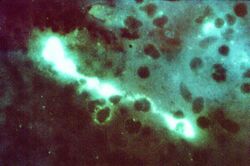Biology:Chlamydophila
| Chlamydophila | |
|---|---|

| |
| Chlamydophila psittaci | |
| Scientific classification | |
| Domain: | Bacteria |
| Phylum: | Chlamydiota |
| Class: | Chlamydiia |
| Order: | Chlamydiales |
| Family: | Chlamydiaceae |
| Genus: | Chlamydophila Everett, Bush & Andersen 1999 |
| Type species | |
| Chlamydophila psittaci (Lillie 1930) Everett, Bush & Andersen 1999
| |
| Species[1] | |
| |
| Synonyms | |
| |
Chlamydophila is a controversial bacterial genus belonging to the family Chlamydiaceae.[2]
Taxonomy
All Chlamydiota are anaerobic bacteria with a biphasic developmental lifecycle that depends on obligately intracellular growth in eukaryotic host cells.
Chlamydophila was recognized by a number of scientists in 1999,[3] with six species in Chlamydophila and three in the original genus, Chlamydia. This was immediately seen as controversial.[4] In 2015 the Chlamydophila species were reclassified as Chlamydia.[4] The history of the classification and reclassification is as follows.
Earlier criteria for differentiation of chlamydial species did not always work well. For example, at that time genus C. psittaci was distinguished from C. trachomatis by sulfadiazine resistance, although not all strains identified as C. psittaci at the time were resistant, and C. pneumoniae was classified by its appearance under electron microscopy (EM) and its ability to infect humans, although the EM appearance may differ from one research group to the next, and many of these species infected humans.
The systematic taxonomy established for Chlamydiota (formerly Chlamydiae) in 1999 used DNA-DNA reassociation, 16S and 23S ribosomal RNA gene similarity, sequence similarity clustering of protein coding genes, and genome size as criteria for classification. Supporting criteria such as antigen detection,[5] glycogen staining, host association, and EM morphology were also employed, depending on applicability and availability.
Comparative genomic analyses in 2006 identified a number of signature proteins that were uniquely present in species from the genera Chlamydia and Chlamydophila, which supported the distinctness of Chlamydophila.[6] This view was challenged three years later by newer whole genome analysis techniques leading to a proposal to "reunite the Chlamydiaceae into a single genus, Chlamydia".[7] By the 2010s this reclassification "was not wholly accepted or adopted"[8] among microbiologists, which "resulted in a reversion to the single, original genus Chlamydia, which now encompasses all 9 species including Chlamydia psittaci."[8] As of 2013, Chlamydophila was still mentioned in some databases, but controversial.[9] The merger of the genus Chlamydophila back into the genus Chlamydia is now generally accepted.[10][11][12][13]
Chlamydophila differentiation
According to the authors of the 1999 study, the mean DNA-DNA reassociation difference distinguishing Chlamydophila from Chlamydia is 10.1%, an accepted value for genus separation. Although the 16S ribosomal RNA gene sequences of the two are close to 95% identical, unlike the other previously established genera, the authors considered a less than 95% similarity only a guideline for establishing new genera in chlamydial families. In the study, the authors used the similarity of the locations of coding for protein and ribosomal RNA genes in the genome (gene clusters) to help distinguish Chlamydophila from Chlamydia. Also, the full-length 23S ribosomal RNA genes of the species of the two genera were less than 95% identical.
| Genus | Approximate Genome Size (million DNA base pairs) | Detectable Glycogen | Number of Ribosomal Operons |
|---|---|---|---|
| Chlamydophila | 1.2 | No | 1 |
| Chlamydia | 1.0 | Yes | 2 |
Phylogeny
| 16S rRNA based LTP_08_2023[14][15][16] | 120 marker proteins based GTDB 08-RS214[17][18][19] | |||||||||||||||||||||||||||||||||||||||||||||||||||||||||||||||||||||||||||||||||||||||||||||||||||||||||||||||||||||||||||||||||||||||||||||
|---|---|---|---|---|---|---|---|---|---|---|---|---|---|---|---|---|---|---|---|---|---|---|---|---|---|---|---|---|---|---|---|---|---|---|---|---|---|---|---|---|---|---|---|---|---|---|---|---|---|---|---|---|---|---|---|---|---|---|---|---|---|---|---|---|---|---|---|---|---|---|---|---|---|---|---|---|---|---|---|---|---|---|---|---|---|---|---|---|---|---|---|---|---|---|---|---|---|---|---|---|---|---|---|---|---|---|---|---|---|---|---|---|---|---|---|---|---|---|---|---|---|---|---|---|---|---|---|---|---|---|---|---|---|---|---|---|---|---|---|---|---|---|
|
|
See also
References
- ↑ J.P. Euzéby. "Chlamydophila". List of Prokaryotic names with Standing in Nomenclature. https://lpsn.dsmz.de/genus/chlamydophila.
- ↑ Chlamydophila at the US National Library of Medicine Medical Subject Headings (MeSH)
- ↑ "Emended description of the order Chlamydiales, proposal of Parachlamydiaceae fam. nov. and Simkaniaceae fam. nov., each containing one monotypic genus, revised taxonomy of the family Chlamydiaceae, including a new genus and five new species, and standards for the identification of organisms". International Journal of Systematic Bacteriology 49 Pt 2 (2): 415–40. April 1999. doi:10.1099/00207713-49-2-415. PMID 10319462.
- ↑ 4.0 4.1 Parte, A.C.. Chlamydia. https://lpsn.dsmz.de/genus/chlamydia.
- ↑ "Molecular evolution of the Chlamydiaceae". International Journal of Systematic and Evolutionary Microbiology 51 (Pt 1): 203–20. January 2001. doi:10.1099/00207713-51-1-203. PMID 11211261.
- ↑ "BLAST screening of chlamydial genomes to identify signature proteins that are unique for the Chlamydiales, Chlamydiaceae, Chlamydophila and Chlamydia groups of species". BMC Genomics 7: 14. January 2006. doi:10.1186/1471-2164-7-14. PMID 16436211.
- ↑ "Divergence without difference: phylogenetics and taxonomy of Chlamydia resolved". FEMS Immunology and Medical Microbiology 55 (2): 115–9. March 2009. doi:10.1111/j.1574-695X.2008.00516.x. PMID 19281563.
- ↑ 8.0 8.1 "Compendium of Measures to Control Chlamydia psittaci Infection Among Humans (Psittacosis) and Pet Birds (Avian Chlamydiosis), 2017". Journal of Avian Medicine and Surgery 31 (3): 262–282. September 2017. doi:10.1647/217-265. PMID 28891690.
- ↑ "Chlamydia/Chlamydophila group". NCBI taxonomy database. National Center for Biotechnology Information, U.S. National Library of Medicine. https://www.ncbi.nlm.nih.gov/Taxonomy/Browser/wwwtax.cgi?mode=Info&id=1113537&lvl=3&lin=f&keep=1&srchmode=1&unlock. "Given the contentious nature of the issue, the NCBI Taxonomy Database retains both genus names for use by submitters."
- ↑ "In Chlamydia veritas". Pathogens and Disease 67 (2): 89–90. March 2013. doi:10.1111/2049-632X.12026. PMID 23620152. https://serval.unil.ch/notice/serval:BIB_998F8DDA064D.
- ↑ "Chlamydia genomics: providing novel insights into chlamydial biology". Trends in Microbiology 22 (8): 464–72. August 2014. doi:10.1016/j.tim.2014.04.013. PMID 24882432.
- ↑ "Emendation of the family Chlamydiaceae: proposal of a single genus, Chlamydia, to include all currently recognized species". Systematic and Applied Microbiology 38 (2): 99–103. March 2015. doi:10.1016/j.syapm.2014.12.004. PMID 25618261.
- ↑ "A Review on Chlamydial Diseases in Animals: Still a Challenge for Pathologists?". Veterinary Pathology 55 (3): 374–390. May 2018. doi:10.1177/0300985817751218. PMID 29310550.
- ↑ "The LTP". https://imedea.uib-csic.es/mmg/ltp/#LTP.
- ↑ "LTP_all tree in newick format". https://imedea.uib-csic.es/mmg/ltp/wp-content/uploads/ltp/LTP_all_08_2023.ntree.
- ↑ "LTP_08_2023 Release Notes". https://imedea.uib-csic.es/mmg/ltp/wp-content/uploads/ltp/LTP_08_2023_release_notes.pdf.
- ↑ "GTDB release 08-RS214". https://gtdb.ecogenomic.org/about#4%7C.
- ↑ "bac120_r214.sp_label". https://data.gtdb.ecogenomic.org/releases/release214/214.0/auxillary_files/bac120_r214.sp_labels.tree.
- ↑ "Taxon History". https://gtdb.ecogenomic.org/taxon_history/.
External links
- Chlamydophila genomes and related information at PATRIC, a Bioinformatics Resource Center funded by NIAID
- Taxonomic Outline of the Procaryotes, Bergey's Manual of Systematic Bacteriology, Second Edition Release 1.0, April c. [1]
Wikidata ☰ Q2442594 entry
 |

